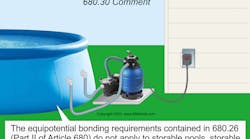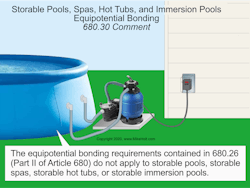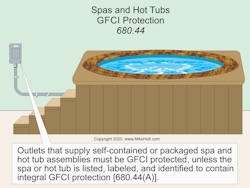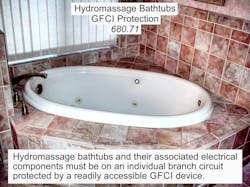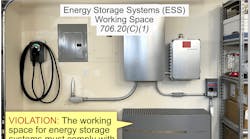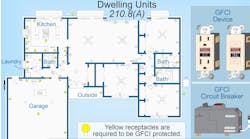Courtesy of www.MikeHolt.com. Based on the 2020 NEC.
Part III of Art. 680 covers storable pools, spas, hot tubs, and immersion pools. Permanently installed versions of these are covered by Part IV.
Storables
Electrical installations for storable pools, spas, hot tubs, and immersion pools must comply with Part I and Part III of Art. 680 [Sec. 680.30]. The equipotential bonding requirements in Sec. 680.26 (Part II of Art. 680) do not apply (Fig. 1).
A cord-connected pool filter pump must incorporate an approved system of double insulation (or equivalent) and have means for terminating an equipment grounding conductor (EGC) for the non-current-carrying metal parts of the pump [Sec. 680.31]. An EGC must be run with the power-supply conductors in the flexible cord.
Cord-connected pool filter pumps must be provided with GFCI protection that is an integral part of the attachment plug or located in the power-supply cord within 12 in. of the attachment plug.
GFCI protection is required for electrical equipment associated with storable pools — and for all 15A and 20A, 125V receptacles within 20 ft from the inside walls of a storable pool, storable spa, or storable hot tub [Sec. 680.32].
Receptacles must be at least 6 ft from the inside walls of a storable pool, storable spa, or storable hot tub. The receptacle distance is measured as the shortest path a flexible cord would follow without passing through a wall, doorway, or window [Sec. 680.34].
Storable and portable immersion pools must comply with the additional requirements of Sec. 680.35(A) through (G). For example, a pump not built into the storable or portable immersion pool must be listed, labeled, and identified for swimming pool use [Sec. 680.35(B)], and lighting outlets must be at least 10 ft from the nearest point of an immersion pool unless within the low-voltage contact limit [Sec. 680.35(E)].
Permanent installations
Electrical installations for permanently installed spas and hot tubs must comply with Part I and Part IV [Sec. 680.40].
A clearly labeled emergency shutoff is required for the permanently installed spa or hot tub water recirculation and jet system (except in a one-family dwelling). The emergency shutoff must be readily accessible and at least 5 ft away, adjacent to, and within sight of the spa or hot tub [Sec. 680.41]. Either the maintenance disconnect [Sec. 680.13] or a pushbutton that controls a relay located per this section would meet the emergency shutoff requirement.
Equipotential bonding of perimeter surfaces [Sec. 680.26(B)(2)] for permanently installed outdoor spas and hot tubs is not required if all the following conditions apply [Sec. 680.42(B)]. The spa or hot tub:
(1) Is listed, labeled, and identified as a self-contained spa or hot tub for aboveground use.
(2) Is not identified as suitable only for indoor use.
(3) Is on or above grade.
(4) Top rim is at least 28 in. above any perimeter surface within 30 in. of the spa or hot tub. Nonconductive external steps do not apply to the rim height measurement.
What about interior wiring for outdoor spas and hot tub installations? You can run any Chapter 3 wiring method inside a dwelling unit and out to the disconnect of an outdoor spa or hot tub [Sec. 680.42(C)].
Electrical installations for an indoor spa or hot tub must comply with Parts I and II except as modified by this section [Sec. 680.43]. Indoor installations of spas or hot tubs can be connected by any of the wiring methods contained in Chapter 3. But the equipotential bonding requirements for perimeter surfaces in Sec. 680.26(B)(2) do not apply to a listed self-contained spa or hot tub installed above an indoor finished floor.
At least one 15A or 20A, 125V receptacle must be installed on a general-purpose branch circuit, between 6 ft and 10 ft from the inside wall of a spa or hot tub [Sec. 680.43(A)].
Receptacles:
- Must be at least 6 ft (measured horizontally) from the inside walls of the spa or hot tub.
- Rated 30A, 125V or less, and within 10 ft of the inside walls of a spa or hot tub must be GFCI protected.
- That provide power for spa or hot tub equipment must be GFCI protected.
Switches must be at least 5 ft (measured horizontally) from the inside wall of the indoor spa or hot tub [Sec. 680.43(C)].
Outlets that supply self-contained or packaged spa and hot tub assemblies must be GFCI protected, unless the spa or hot tub is listed, labeled, and identified to contain integral GFCI protection [Sec. 680.44(A)], as shown in Fig. 2.
Electrical installations at permanently installed immersion pools, whether indoors or outdoors, must comply with Parts I, II, and IV (except as modified by Sec. 680.45) and must be connected by Chapter 3 wiring methods. Concerning the provisions in Part IV, an immersion pool is considered to be a spa or hot tub.
Fountains
The general installation requirements in Part I apply to fountains (including splash pads) intended for recreational use by pedestrians, in addition to those requirements in Part V [Sec. 680.50]. Part II applies to fountains that have water common to pools. Some key requirements include:
- GFCI protection is required for luminaires, submersible pumps, and other submersible equipment unless listed and supplied by a transformer or power supply that complies with Sec. 680.23(A)(2) [Sec. 680.51(A)].
- Install luminaires so the top of the luminaire lens is below the normal water level unless listed for above-water use [Sec. 680.51(C)].
- The maximum length of each exposed flexible cord in a fountain is 10 ft. Power-supply cords that extend beyond the fountain perimeter must be enclosed in a wiring enclosure approved by the authority having jurisdiction [Sec. 680.51(E)].
- Equipment must be removable (from the water) for normal maintenance and relamping [Sec. 680.51(F)].
- Equipment must be inherently stable or be securely fastened in place [Sec. 680.51(G)].
Connect the following to the circuit EGC [Sec. 680.54(A)]:
- All electrical equipment within the fountain or within 5 ft of the inside wall of the fountain, other than listed low-voltage luminaires not requiring grounding.
- All electrical equipment associated with the recirculating system of the fountain.
- Panelboards that supply any electrical equipment associated with the fountain (and are not part of the service equipment).
Bond the following together [Sec. 680.54(B)] and connect to an EGC on a branch circuit supplying the fountain:
- All metal piping systems associated with the fountain.
- All metal fittings within or attached to the fountain.
- Metal parts of electrical equipment associated with the fountain water-circulating system, including pump motors.
- Metal raceways within 5 ft of the inside wall or perimeter of the fountain and not separated from it by a permanent barrier.
- All metal surfaces within 5 ft of the inside wall or perimeter of the fountain and not separated from it by a permanent barrier.
- Electrical devices and controls not associated with the fountain and less than 5 ft from its inside wall or perimeter.
The requirements to install an insulated copper EGC of Sec. 680.21(A), Sec. 680.23(B)(3), Sec. 680.23(F)(1) and (2), Sec. 680.24(F), and Sec. 680.25 apply to fountains [Sec. 680.55 (A)]. Fountain equipment supplied by a flexible cord must have all exposed metal parts connected to an insulated copper EGC that is an integral part of the cord [Sec. 680.55(B)].
The following must be GFCI-protected:
- All electrical equipment, including power-supply cords [Sec. 680.56(A)].
- Each branch circuit or feeder that supplies an electric sign installed within a fountain or within 10 ft of the fountain edge [Sec. 680.57].
- All 15A and 20A, single-phase, 125V through 250V receptacles within 20 ft of the fountain’s edge [Sec. 680.58].
- Outlets supplying permanently installed nonsubmersible pump motors rated 250V or less and 60A or less [Sec. 680.59].
Hydromassage bathtubs
A hydromassage bathtub must comply with only the requirements of Part VII — not any other requirements in Art. 680 [Sec. 680.70].
Hydromassage bathtubs and their associated electrical components must be on an individual branch circuit protected by a readily accessible GFCI device [Sec. 680.71], as shown in Fig. 3.
All 125V, single-phase receptacles not greater than 30A (and located within 6 ft horizontally of the inside walls of a hydromassage tub) must be GFCI protected.
Bond the parts that are listed in Sec. 680.74(A)(1) through (5). For example, bond metal parts of electrical devices not associated with the hydromassage bath if they are within 5 ft of it. Double-insulated motors and small conductive surfaces unlikely to become energized don’t have to be bonded [Sec. 680.74, Exception No. 1 and Exception No. 2]. But you must provide a bonding jumper long enough to terminate on a replacement nondouble-insulated pump or blower motor.
Ensuring it’s safe
By now, it should be clear that permanently installed pools aren’t the only small manmade bodies of water with strict installation requirements. And keeping track of compliance can be challenging. Here’s a tip for visually checking compliance with the many bonding requirements. Make a drawing that shows the EGC and all the metallic objects in or near the installation. Anywhere there’s not a connection from one of those objects to the EGC, you probably have a violation; check the applicable requirements.
These materials are provided to us by Mike Holt Enterprises in Leesburg, Fla. To view Code training materials offered by this company, visit www.mikeholt.com/code.
